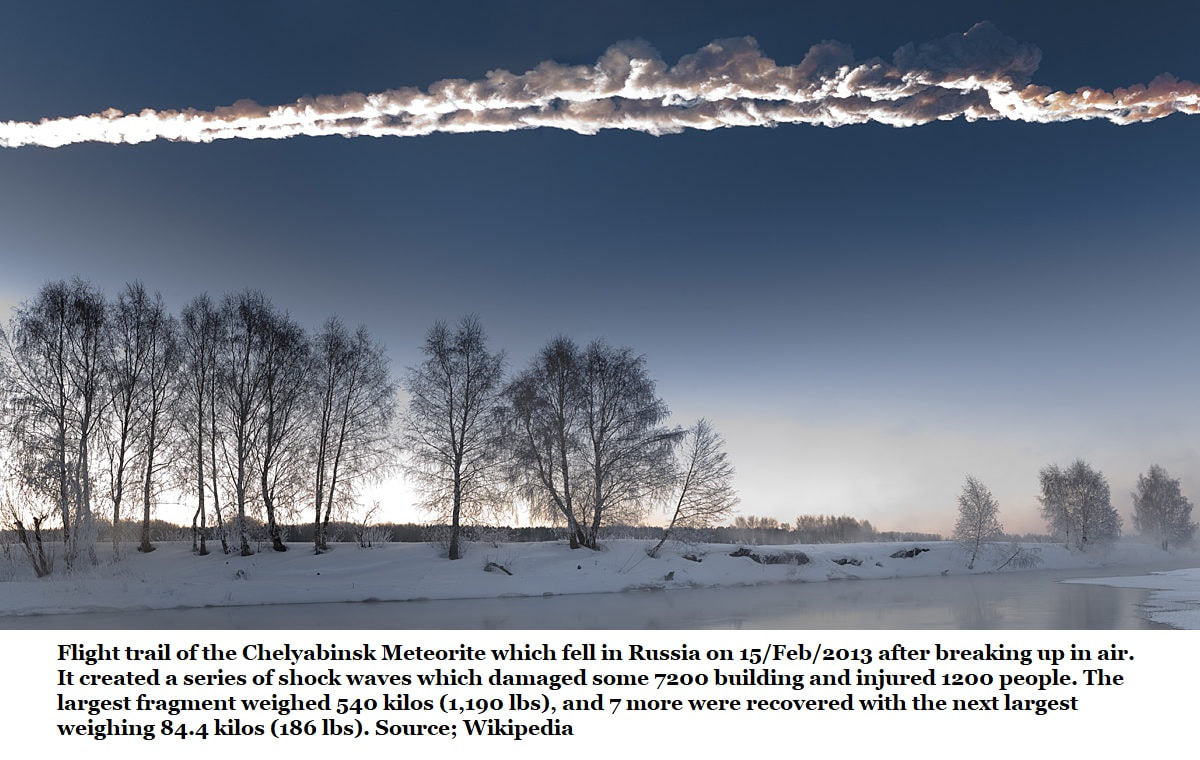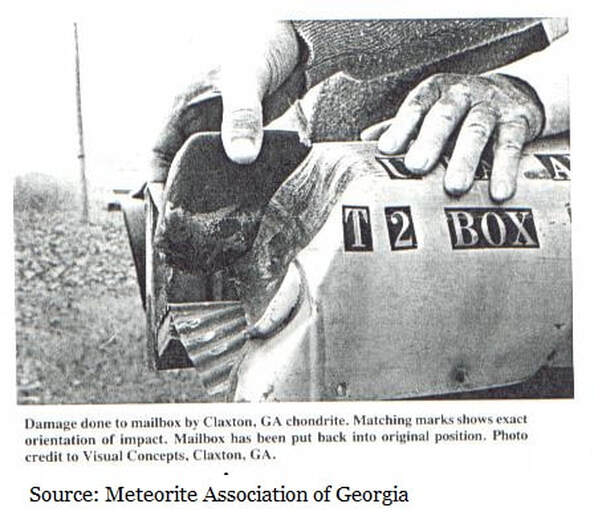27C: Georgia's Witnessed Meteorite Falls
By
Thomas Thurman
Added 24/April/2022

A witnessed meteorite fall simply means that the fall was seen or heard, and the sample was recovered afterwards. Most meteorites, by far, are simply discovered on the ground and when they fell is unknown. There are six witnessed meteorite falls in Georgia’s natural history: Forsyth, Lumpkin, Pitts, Thomson, Claxton & Cartersville.
The Forsyth Fall is Georgia’s oldest and the fifth oldest in the USA’s history.
First Five Witnessed Meteorite Falls in the USA
Meteorite Name State Month.Year Weight
1: Weston Connecticut Dec. 1807 150 kilos (330 lbs)
2: Carswell North Carolina Jan. 1810 1.36 kilos (2.9 lbs)
3: Nobleboro Maine Aug. 1823 2.3 kilos (5.07 lbs)
4: Nanjemoy Maryland Feb. 1825 7.5 kilos (16.5 lbs)
5: Forsyth Georgia May 1829 16 kilos (35.2 lbs)
Meteorite Name State Month.Year Weight
1: Weston Connecticut Dec. 1807 150 kilos (330 lbs)
2: Carswell North Carolina Jan. 1810 1.36 kilos (2.9 lbs)
3: Nobleboro Maine Aug. 1823 2.3 kilos (5.07 lbs)
4: Nanjemoy Maryland Feb. 1825 7.5 kilos (16.5 lbs)
5: Forsyth Georgia May 1829 16 kilos (35.2 lbs)
The stories for 4 of these witnessed falls are told in the 1966 report Meteorites of Georgia, published by the Georgia Geologic Survey and written by E. P. Henderson of the Smithsonian and A. S. Furcron of the Georgia survey. The last two are reported by Meteorite Association of Georgia on their website, meteoriteassociationofgeorgia.org.
The stories for 4 of these witnessed falls are told in the 1966 report Meteorites of Georgia, published by the Georgia Geologic Survey and written by E. P. Henderson of the Smithsonian and A. S. Furcron of the Georgia survey. The last two are reported by Meteorite Association of Georgia on their website, meteoriteassociationofgeorgia.org.
Meteorites in Georgia’s History
The Meteorite Association of Georgia recognizes 25 meteorites in our natural history, but the historic literature discusses 30 meteorites; though several of these are lost to history or may actually be part of another fall. Because this website strives for historical accuracy; it’ll list all 30 with notations where needed.
The Meteorite Association of Georgia recognizes 25 meteorites in our natural history, but the historic literature discusses 30 meteorites; though several of these are lost to history or may actually be part of another fall. Because this website strives for historical accuracy; it’ll list all 30 with notations where needed.
Meteorites
Meteorites are classified into three broad categories
Meteorites are classified into three broad categories
- Irons
- Stones
- Stony-Irons
You might have seen the TV show Meteorite Hunters finding specimens with their metal detectors. Because of the wealth of natural iron minerals in Georgia’s soils, such metal detecting for meteorites would be difficult.
Limonite, for instance, is an iron ore. there are many Coastal Plain roadside beds of pea-sized limonite pebbles where a large percentage of pebbles will respond to a magnet. With that in mind, there are diagnostic features at the end of this article to help identify a possible meteorite.
Limonite, for instance, is an iron ore. there are many Coastal Plain roadside beds of pea-sized limonite pebbles where a large percentage of pebbles will respond to a magnet. With that in mind, there are diagnostic features at the end of this article to help identify a possible meteorite.
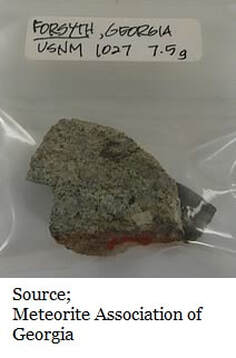
Forsyth Meteorite
Monroe County
1829
It was May 08, 1829 at 3:30 when the first witnessed meteorite fall occurred in Georgia.
Benjamin Silliman investigated the event soon afterward and reported in 1830. “…a small black cloud appeared south of Forsyth from which two distinct explosions were heard, following in immediate succession, succeeded by a tremendous rumbling or whizzing noise passing through the air, which lasted from the account for two to five minutes.” Silliman reported his findings in the American Journal of Science.
“This extraordinary noise was on the same evening accounted for by Mr. Sparks and Captain Postain, who happened to be near some Negroes (original text, in 1829 these were very likely slaves) working in a field, one mile south of this place, who discovered a large stone descending through the air, whose weight, as was afterwards ascertained, was 36 pounds (16.3 kilos)."
"The stone was, in the course of the evening or very early next morning recovered from the spot where it fell. It penetrated the Earth 2.5 feet (.7 meter)”
Monroe County
1829
It was May 08, 1829 at 3:30 when the first witnessed meteorite fall occurred in Georgia.
Benjamin Silliman investigated the event soon afterward and reported in 1830. “…a small black cloud appeared south of Forsyth from which two distinct explosions were heard, following in immediate succession, succeeded by a tremendous rumbling or whizzing noise passing through the air, which lasted from the account for two to five minutes.” Silliman reported his findings in the American Journal of Science.
“This extraordinary noise was on the same evening accounted for by Mr. Sparks and Captain Postain, who happened to be near some Negroes (original text, in 1829 these were very likely slaves) working in a field, one mile south of this place, who discovered a large stone descending through the air, whose weight, as was afterwards ascertained, was 36 pounds (16.3 kilos)."
"The stone was, in the course of the evening or very early next morning recovered from the spot where it fell. It penetrated the Earth 2.5 feet (.7 meter)”
The “two distinct explosions” were of course sonic booms produced by the meteorite. The “rumbling-whizzing” was the sound of its flight through the air as it decelerated from air-resistance. These were sounds people in 1829 had never heard. Thunder was their closest experience.
This was a stony meteorite; The Meteorite Association of Georgia classifies it as a "Stone. Olivine-hyperqthene chondrite (L6), veined."
This was a stony meteorite; The Meteorite Association of Georgia classifies it as a "Stone. Olivine-hyperqthene chondrite (L6), veined."
For the record most meteorites leave little to no impact evidence. To quote Meteorites in Georgia; “Occasionally a meteorite strikes our earth with enough force to make an impact crater but usually meteorites are so retarded in their fall (slowed by air resistance) that they neither seriously deface themselves nor penetrate the ground very far.”
Although 35 pounds of the Forsyth Meteorite were recovered, most of it was lost.
Although 35 pounds of the Forsyth Meteorite were recovered, most of it was lost.
The Histories
Sadly, the 1966 report Meteorites of Georgia is not available online. As far as I could tell it has never been scanned and posted as a PDF. My personal copy is pretty clean, there are a few notes and highlighted texts, so if an institution wanted to borrow it and scan it for public usage, I would certainly be willing to assist. I would expect it to be returned in good condition.
The authors, Henderson and Furcron report in 1966 that with observed falls where a specimen was recovered, the ratio is 25 stones for every iron. More recently it has been shown that 86% of meteorites are stones. But since irons are more easily distinguished from native rock they're more commonly reported as finds.
Sadly, the 1966 report Meteorites of Georgia is not available online. As far as I could tell it has never been scanned and posted as a PDF. My personal copy is pretty clean, there are a few notes and highlighted texts, so if an institution wanted to borrow it and scan it for public usage, I would certainly be willing to assist. I would expect it to be returned in good condition.
The authors, Henderson and Furcron report in 1966 that with observed falls where a specimen was recovered, the ratio is 25 stones for every iron. More recently it has been shown that 86% of meteorites are stones. But since irons are more easily distinguished from native rock they're more commonly reported as finds.

Lumpkin Meteorite
Stewart County
1869
On 06/October/1869 a 12.25 ounce (347 grams) stony meteorite fell near Lumpkin, in Stewart County, Georgia.
It struck on land owned by Captain Elbridge Barlow located about 12 miles southwest of Lumpkin. It was picked-up a few minutes after it struck.
J. E. Willet investigated the fall and published a report in an 1870 edition of American Journal of Science.
Willet quotes Captain Barlow; “…while standing in the open yard, the sky being bright and clear, he heard the first in a succession of about three explosions, following by a deep roaring for several seconds and then by a rushing or whizzing sound of something rushing with great speed through the air nearby. The sound ceased suddenly. The noise continued from first to last about half a minute.”
“Two Negroes were working near by the well in the same yard, about sixty yards from where Captain Barlow stood. They heard the noise and supposed it to be the falling-in of the plank well curbing, banging from side to side in its descent, and so spoke of it to one another before the meteorite fell.”
Willet quotes Captain Barlow; “…while standing in the open yard, the sky being bright and clear, he heard the first in a succession of about three explosions, following by a deep roaring for several seconds and then by a rushing or whizzing sound of something rushing with great speed through the air nearby. The sound ceased suddenly. The noise continued from first to last about half a minute.”
“Two Negroes were working near by the well in the same yard, about sixty yards from where Captain Barlow stood. They heard the noise and supposed it to be the falling-in of the plank well curbing, banging from side to side in its descent, and so spoke of it to one another before the meteorite fell.”
“While they were speaking thus about the noise the meteorite fell and struck the ground about twenty steps from them, in full sight knocking up the dirt.”
“They called Captain Barlow and showed him the spot. It was upon very hard, trodden ground in the clean open yard. The earth was freshly loosened up very fine in a circle about 18 inches in diameter, and upon scraping the loose dirt away with hands the stone was found about 10 inches below the surface.”
“They called Captain Barlow and showed him the spot. It was upon very hard, trodden ground in the clean open yard. The earth was freshly loosened up very fine in a circle about 18 inches in diameter, and upon scraping the loose dirt away with hands the stone was found about 10 inches below the surface.”
“From the direction in which the ground was crushed in it must have come from the northwest and at an angle of about 30°.”
“The stone when picked up was covered by a black shell… The stone still had a strong odor. He does not remember that it had any noticeable heat.”
“The stone when picked up was covered by a black shell… The stone still had a strong odor. He does not remember that it had any noticeable heat.”
Willet's account mentions that the sounds of the fall were heard over a considerable area and cites an instance of the noise being heard 18 miles away.
In 1870 J. L. Smith reported that the meteorite contained about 7% Ni-Fe (nickel iron) and the iron was 12% nickel. Troilite made up 6.1 % and silicate (pyroxene, olivine & feldspars) made up 86.9%, But these descriptions are not sufficient to identify it and since the existing samples in various collections are so small it is unlikely (1966 text) that a comprehensive study of this meteorite will ever be made.
In 1870 J. L. Smith reported that the meteorite contained about 7% Ni-Fe (nickel iron) and the iron was 12% nickel. Troilite made up 6.1 % and silicate (pyroxene, olivine & feldspars) made up 86.9%, But these descriptions are not sufficient to identify it and since the existing samples in various collections are so small it is unlikely (1966 text) that a comprehensive study of this meteorite will ever be made.
Willet reported in 1870 that a specimen of the Lumpkin stone was given to Mercer University, Macon, Georgia but the authors (1966) were unable to verify if the sample is preserved.
The illustrated portion is held by the Smithsonian.
The illustrated portion is held by the Smithsonian.
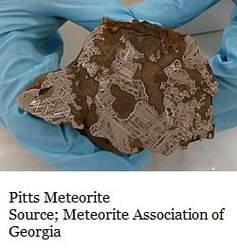
Pitts Iron Meteorite
Wilcox County. 1921
The Pitts meteorite fell on 20/April/1921 at about 9am, it’s referred to as an iron with silicate inclusions. Four distinct specimens were recovered from a trapezoid shaped strewn field 5,000ft by 3,000ft which suggest the meteor was travelling southwest.
Wilcox County. 1921
The Pitts meteorite fell on 20/April/1921 at about 9am, it’s referred to as an iron with silicate inclusions. Four distinct specimens were recovered from a trapezoid shaped strewn field 5,000ft by 3,000ft which suggest the meteor was travelling southwest.
Samuel McCallie, our intrepid and thorough State Geologist of the day, was never happy with the description “iron with silicate inclusions” and described both the fall and the meteorite in 1922. McCallie was ever the scientist.
He noted that there was an abundance of silicates in the iron meteorite, and that much more silicate material seemed to have burned away during passage through the atmosphere.
He noted that there was an abundance of silicates in the iron meteorite, and that much more silicate material seemed to have burned away during passage through the atmosphere.
McCallie goes on to share witness descriptions... “At the time of the fall no clouds were in view and the sun was shining brightly. It was seen as far north as Sunny Side, in Henry County, 36 miles south of Atlanta, and as far south as Moultrie, in Colquitt County. In addition to the above towns which appear to mark the north and south limits of its visibility, it was also seen at Camilla, Albany, Seville, Cordele, Hawkinsville, Perry, Macon, and Alma.”
In an article for the Cordele Dispatch and Daily Sentinel, 10/May/1921, McCallie reported; “Dense smoke in the wake of the flaming fire ball was referred to by the Albany and Moultrie witnesses as a luminous trail following the flaming ball. Colonel Doris, who was in the vicinity of Pitts speaks of the smoke as a zig-zag trail lingering for several minutes and assuming various shapes.”
The zig-zag shape would have been the atmospheric influences of high-altitude winds on the lingering smoke trail after the meteorite had passed.
The zig-zag shape would have been the atmospheric influences of high-altitude winds on the lingering smoke trail after the meteorite had passed.
“The first sound heard was compared to that of thunder and to many it was the first warning that an unusual occurrence was taking place in the sky above. At Cordele, 15 miles west of Pitts the sounds resembled that of a heavy explosion distinctly heard by several people in the street. In the countryside 4 miles east of Cordele, two terrific explosions were noted (sonic booms), louder than thunder which so terrified the farm hands that they ran frightened to their homes.”
“At Hawkinsville it was thought than an airplane had exploded over the city. In the immediate vicinity of Pitts the sounds were described as several loud explosions causing the earth to tremble, followed in quick succession by a number of lesser explosions.” (The meteor breaking up?)
The Pitts Iron broke up in air as 4 individual pieces were recovered over an area of a few thousand feet. One piece struck about 75 feet from Nancy Brinson’s home and was recovered within a few minutes. Although it penetrated the ground about 16 inches it was not hot when it was found.
Piece #2 fell about 700 feet southwest of the Brinson house, this one contained stony inclusions, weighed 42 oz (1,190 grams) and penetrated the earth to 8 inches. This piece nearly made history as it fell so close to a boy that it “splattered him with flying dirt.”
Piece #3 struck about 4,000 ft southwest of #2 and within 100 feet of where a man and boy were working in King’s field. It penetrated to 7” and was said to be still warm to the touch when recovered.
Piece #4 fell unobserved on a public road 5,000 southwest of #1 and weighed less than 2 ounces. The authors note that other pieces probably fell but as more than a century has passed it would be difficult to located additional specimens.
As a reminder, natural iron ore occurs commonly on Georgia’s Coastal Plain as limonite in several varieties, thus making prospecting by metal detector very difficult.
The 1966 report references a May 1921 article in the magazine section of the Atlanta Constitution written by Samuel McCallie which featured a picture of all for samples recovered. This is the only known image of all 4 specimens but the details of the picture are reported as “not good”. Henderson and Furcron speculate that there might be negative of the picture still available. That seems unlikely in 1966, but highly improbably not in 2022. Henderson and Furcron lament; “Unfortunately, the surface features of the other specimens seem to have been overlooked because there is no mention of any particular features they display.”
The 1966 report references a May 1921 article in the magazine section of the Atlanta Constitution written by Samuel McCallie which featured a picture of all for samples recovered. This is the only known image of all 4 specimens but the details of the picture are reported as “not good”. Henderson and Furcron speculate that there might be negative of the picture still available. That seems unlikely in 1966, but highly improbably not in 2022. Henderson and Furcron lament; “Unfortunately, the surface features of the other specimens seem to have been overlooked because there is no mention of any particular features they display.”
On 23/April/1939 the same publication carried the note; “Georgia Star Sold” announcing that the Pitts Iron was sold to S. H. Perry of Adrian, Michigan. The headline was generated when some locals feared that the Pitts Iron would become lost to Georgia and buried in a private collection. But Perry donated it to the U. S. National Museum (now the Smithsonian) for preservation.
Henderson & Furcron offer a fairly detailed analysis of the Pitts Iron but they admit that they only had access to a single portion, that the meteorite had been described and studied many times over the years but almost not at all when it was still fresh. The also express concerns over how well the sample McCallie studied was prepared. Since the meteorite is well described elsewhere, I won’t go into detail about it here. However; Henderson & Furcron commented in 1966; "The Pitts meteorite illustrates a serious defect in the way scientific specimens are cared for."
Thomson Stone
McDuffie County, 1888
A 234 gram stony meteorite, a chondrite, was acquired by the US National Museum (Smithsonian) in 1909 from George H. Plant of Macon. Little is known about the stone’s early history as it had been in private hands for many years before Plant acquired the specimen.
Plant presented an accompanying letter dated 26/November/1888 from B. F. Wilson to which stated the stone “… was picked up by the undersigned (Wilson) on 15/October four miles south of Thomson. It fell within thirty yards of where the writer was at work.”
McDuffie County, 1888
A 234 gram stony meteorite, a chondrite, was acquired by the US National Museum (Smithsonian) in 1909 from George H. Plant of Macon. Little is known about the stone’s early history as it had been in private hands for many years before Plant acquired the specimen.
Plant presented an accompanying letter dated 26/November/1888 from B. F. Wilson to which stated the stone “… was picked up by the undersigned (Wilson) on 15/October four miles south of Thomson. It fell within thirty yards of where the writer was at work.”
Wilson was reportedly picking cotton at the time and thought someone had thrown the stone at him. He then noticed where the meteorite fell thirty steps away and it was buried 6 to 8 inches in the ground. He dug it out with a spade.
Wilson reported that the falling stone made no sound that he recalled. Henderson and Furcron comment that silent falls aren’t uncommon, and the sounds of atmospheric entry and travel may have been too far away for Wilson to hear, that by the time it came near Wilson atmospheric braking may have slowed it enough that there was little noise.
Wilson reported that the falling stone made no sound that he recalled. Henderson and Furcron comment that silent falls aren’t uncommon, and the sounds of atmospheric entry and travel may have been too far away for Wilson to hear, that by the time it came near Wilson atmospheric braking may have slowed it enough that there was little noise.

Claxton Stone; 1984
The Meteorite Association of Georgia records that on 10/December/1984 a 1,455 gram (51.32 ounces or 3.2 pound) meteorite fell in Evans County, Georgia striking a mailbox. Hal Povenmire reported the fall and gave the location as 10 km (6.2 miles) southeast of Claxton, Georgia. This was reported by Hal Povernmire (a lost friend who is missed) and published in The SEAN Bulletin 1984.
The Meteorite Association of Georgia records that on 10/December/1984 a 1,455 gram (51.32 ounces or 3.2 pound) meteorite fell in Evans County, Georgia striking a mailbox. Hal Povenmire reported the fall and gave the location as 10 km (6.2 miles) southeast of Claxton, Georgia. This was reported by Hal Povernmire (a lost friend who is missed) and published in The SEAN Bulletin 1984.
Described as a grapefruit sized stone completely covered with a thin black fusion crust the meteorite struck the mailbox and the made a depression in the loose dirt just over an inch (less than 30cm) deep.
Two witnesses 36 meters (118 feet) from the impact and two people inside a mobile home reported a whistling sound followed by a crash and thud as stone fell and struck.
Two witnesses 36 meters (118 feet) from the impact and two people inside a mobile home reported a whistling sound followed by a crash and thud as stone fell and struck.
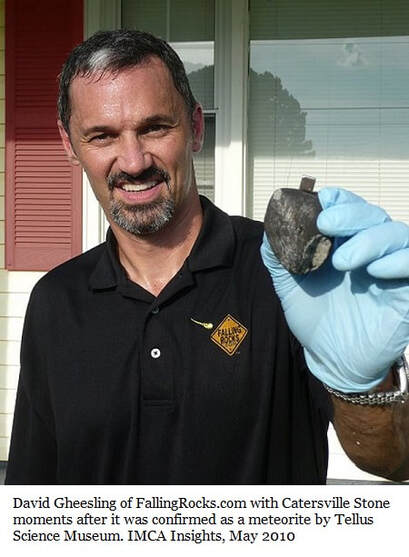
Cartersville Stone; 2009
Our most recent witnessed fall is on display at Tellus Science Museum in Cartersville, GA.
The Meteorite Assocaition of Georgia also reports that on March 1st, 2009, at around 11pm, the impact of this meteorite was heard as it crashed through the roof of a home in Bartow County, Georgia. The 10.3 ounce (294 gram) stone penetrated the home’s roof, ricocheted off a crossbeam in the ceiling, penetrated the ceiling, ricocheted off a door and came to rest on the floor inside the home.
Our most recent witnessed fall is on display at Tellus Science Museum in Cartersville, GA.
The Meteorite Assocaition of Georgia also reports that on March 1st, 2009, at around 11pm, the impact of this meteorite was heard as it crashed through the roof of a home in Bartow County, Georgia. The 10.3 ounce (294 gram) stone penetrated the home’s roof, ricocheted off a crossbeam in the ceiling, penetrated the ceiling, ricocheted off a door and came to rest on the floor inside the home.
There is a link on the association’s website to an article by David Gheesling
The recovered stone appeared to be an air-breakup specimen. An extensive search of the house and the surrounding area was performed but no additional material was recovered. The local terrain was not friendly to finding further specimens.
The recovered stone appeared to be an air-breakup specimen. An extensive search of the house and the surrounding area was performed but no additional material was recovered. The local terrain was not friendly to finding further specimens.
Did I Find a Meteorite?
First of all, accept the fact that you probably did not, but continue with the observations and test procedures below… If your find passes all the tests below, you can contact the author for further guidance. (Thomas Thurman; [email protected])
Meteorites fall into three broad classifications
First of all, accept the fact that you probably did not, but continue with the observations and test procedures below… If your find passes all the tests below, you can contact the author for further guidance. (Thomas Thurman; [email protected])
Meteorites fall into three broad classifications
- Irons
- Stones
- Stony-Irons
Be aware, Georgia has a great deal of natural iron, especially near the Fall Line and on the Coastal Plain. Georgia’s famous red clay is generally clay that has been stained by oxidize iron; rust. So can your find be explained by naturally occurring iron minerals?
Our natural terrestrial iron will almost always be found with sand, encrusted in sand, and often with sand inclusions. If you see sand included on your find, it is probably not a meteorite. If there is sand inside your find, it is not a meteorite.
However, there was one large, confirmed Georgia meteorite which had been buried for so long that it was encrusted with sand, so continue to the tests below.
Not to discourage anyone, but naturally occurring iron, slag, and three centuries of habitation by an iron using civilization have left many not-meteorites in the soil for us to find.
#1; Context
- Does your find match the rocks of the local terrain?
- Use a hammer and break open other local rocks and critically compare them to your find.
- Bear in mind that meteorites are never abundant in any local area.
#2; Crust
- There will often be a fusion crust on the surface
#3; Magnet Test
- All irons will respond strongly to a magnet.
- The vast majority of stones have enough iron in them to respond to a magnet.
- Does your find respond to a magnet?
#4; Inclusions or veins?
- There will often be metallic inclusions surrounding silicate bodies, possibly rounded bodies.
- Do you see thin black veins?
#5; Bright scratch
- Fresh scratches on an iron meteorite will be bright, like bare metal, the color of a 5 cent coin.
- Fresh scratches on terrestrial iron will be dark, rust colored.
- If you get a bright scratch, polish a small spot with a whetstone, is the whole polished spot bright?
#6; Is the iron softish?
- Meteoritic iron is malleable, meaning it will bend or is on the soft side. You can dent it.
- Natural terrestrial and man-made irons are both brittle, they will break instead of bend.
#7; Nickle
- Nickel test kits are available at Walmart and pharmacies, they are used to test jewelry by those who are allergic to nickel.
- Iron meteorites are fairly rich in the metal nickel.
- Terrestrial & manmade iron is nearly devoid of nickel.
- Test for the find nickel, if the test is positive, test again.
- If your find meets all of the above tests and survives three separate tests for nickel, it is time to have it looked at by someone with the experience to confirm it.
- You can email the author for suggestions
- Thomas Thurman; [email protected]
References
- Henderson, E. P.; Furcron A. S.; Meteorites of Georgia, Department of Mines, Mining & Geology, 1966
- Silliman, B.; 1830, Georgia Meteorite & Aerolite. American Journal of Science, (1) Vol. 18 pp. 388-399
- Willet, J.E.; 1870, Account of the Fall of a Meteoric Stone in Stewart County, Georgia. American Journal of Science, (2). Vol. 50, Pg. 335-338
- Smith, J. L.; Fall of a Meteorite in Stewart County, Georgia. American Journal of Science, (2) vol.50, pg 339-341,p.293.
- McCallie, S.W.1922. The Pitts Meteorite, The American Journal of Science; Vol. 3, Pg 211-215
- Merrill, G.P.; A Heretofore Undescribed Stony Meteorite from Thomson, McDuffie County. GA; Smith, Misc, Vol. V, pp 473-476
- Gheesling, David; The Cartersville Meteorite; IMCA Insights, May. 2010 IMCA Insights – May 2010
- Povenmire, H; Fall of the Claxton, USA, Stony Meteorite, SEAN Bulletin, 1984, 9, no. 11; Florida Fireball Patrol, Indian Harbor Beach, Florida






